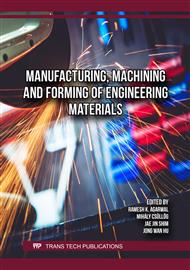[1]
V. Tagliaferri, F. Trovalusci, S. Guarino and S. Venettacci: Environmental and Economic Analysis of FDM, SLS and MJF Additive Manufacturing Technologies (Materials 2019, 12 (24)
DOI: 10.3390/ma12244161
Google Scholar
[2]
M. Schmid, A. Amado and K. Wegener: Materials perspective of polymers for additive manufacturing with selective laser sintering (Journal of Materials Research 2014, 29 (17)
DOI: 10.1557/jmr.2014.138
Google Scholar
[3]
V.Shanmugam, O. Das, K. Babu, U. Marimuthu, A. Veerasimman, D.J. Deepak, R.E. Neisiany, M. Hedenqvist, S. Ramakrishna and F. Berto: Fatigue behaviour of FDM-3D printed polymers, polymeric composites and architected cellular materials (International Journal of Fatigue 2021, 143
DOI: 10.1016/j.ijfatigue.2020.106007
Google Scholar
[4]
S. Terekhina, T. Tarasova, S. Egorov, L. Guillaumat and M.L. Hattali: On the difference in material structure and fatigue properties of polyamide specimens produced by fused filament fabrication and selective laser sintering (The International Journal of Advanced Manufacturing Technology 2020, 111 (2)
DOI: 10.1007/s00170-020-06026-x
Google Scholar
[5]
R. Chen, Y. Lu, P. Witherell, T.W. Simpson, S. Kumara and H. Yang: Ontology-Driven Learning of Bayesian Network for Causal Inference and Quality Assurance in Additive Manufacturing (IEEE Robotics and Automation Letters 2021, 6 (3)
DOI: 10.1109/lra.2021.3090020
Google Scholar
[6]
G. Seo, Md.R.U. Ahsan, Y. Lee, J. Shin, H. Park and D.B. Kim, : A functional modelling approach for quality assurance in metal additive manufacturing (Rapid Prototyping Journal 2021, 27 (2)
DOI: 10.1108/rpj-12-2018-0312
Google Scholar
[7]
H. Fayazfar, M. Salarian, A. Rogalski, D. Sarker, P. Russo, V. Paserin and E. Toyserkani, : A critical review of powder-based additive manufacturing of ferrous alloys: Process parameters, microstructure and mechanical properties (Materials & Design 2018, 144
DOI: 10.1016/j.matdes.2018.02.018
Google Scholar
[8]
Y. Al-Meslemi, N. Anwer and L. Mathieu, : Environmental Performance and Key Characteristics in Additive Manufacturing: A Literature Review (Procedia CIRP 2018, 69
DOI: 10.1016/j.procir.2017.11.141
Google Scholar
[9]
A. Pilipovic, T. Brajlih and I. Drstvensek: Influence of Processing Parameters on Tensile Properties of SLS Polymer Product (Polymers 2018, 10 (11)
DOI: 10.3390/polym10111208
Google Scholar
[10]
B. van Hooreweder and J-P. Kruth: High cycle fatigue properties of selective laser sintered parts in polyamide 12 (CIRP Annals 2014, 63 (1), doi: 10.1016/j.cirp.2014.03.060 )
DOI: 10.1016/j.cirp.2014.03.060
Google Scholar
[11]
A. Salazar, A. Rico, J. Rodriguez, J. Segurado Escudero, R. Seltzer and F. La Martin de Escalera Cutillas: Fatigue crack growth of SLS polyamide 12: Effect of reinforcement and temperature (Composites Part B: Engineering 2014, 59
DOI: 10.1016/j.compositesb.2013.12.017
Google Scholar
[12]
C.T. Henry, E. T. Johnson, A. R. Haynes and A. Tran: Fatigue Performance of Polyamide 12 Additively Manufactured Structures Designed with Topology Optimization (Journal of Testing and Evaluation 2021, 49 (3), doi: 10.1520/JTE20180793 )
DOI: 10.1520/jte20180793
Google Scholar
[13]
J.Y. Kim, H. You, S.J. Kim, G.J. Yun: Effects of porosity on the fatigue life of polyamide 12 considering crack initiation and propagation (Advanced Composite Materials 2020, 29 (4), doi: 10.1080/09243046.2020.1738635 )
DOI: 10.1080/09243046.2020.1738635
Google Scholar


